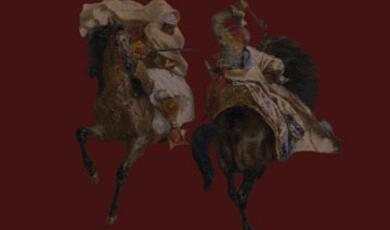Acting on Evidence: How Medical Research has informed Historical Drama
Share
- Details
- Transcript
- Audio
- Downloads
- Extra Reading
John Powell is an experienced medical advisor on a range of television dramas including Casualty 1909 and Downton Abbey. In this lecture he will explain how research in hospital archives and in medical journals has informed drama storylines, and how the television medical advisor works with the writer, the director and the production team on the script and on set.
Download Transcript
18 October 2012
Acting on Evidence:
How Medical Research has
Informed Historical Drama
Professor John Powell
Buried within the minor credits of television dramas, you will sometimes see a line for ‘medical advisor’ or ‘medical consultant’. This lecture aims to illuminate this role, and to describe how medical advice has been used to inform and help create television drama. I am lucky enough to have worked on several television shows, and drawing on my own experience I hope to explain how medical experts attempt to bring authenticity, and on occasion, creativity, to drama productions. In considering what it is the medical advisor does, I’d like first to imagine what a medical drama would be like without one.
For reasons which I will explain, but which have more to do with chance than design, I have developed a particular expertise in historical medical drama. During this lecture I will draw on my work on three shows - Casualty 1909, a drama series produced by Stone City films for BBC1; Downton Abbey, a drama series produced by Carnival Films for ITV1; and Spanish Flu: The Forgotten Fallen, a film made for the BBC by Hardy Pictures.
To start with I will give an overview of my work in this area with some video clips as illustration. I will then talk in some detail about Casualty 1909 and what was required both from a medical advisor perspective, but also from other elements of the production, to really bring to life the inner workings of the London Hospital in that early Edwardian period.
First of all, though, I will just tell you a little more about me and how I got interested in this kind of work in the first place. I am a Professor of Public Health Medicine and therefore have a general interest in the health of the population as a whole. One major challenge for public health practitioners is, and always has been, how we effectively communicate about health issues to the public. This includes both health promoting messages, and warnings about health risks. As a researcher this whole area of health communication has been a focus for me and my academic expertise is, perhaps incongruously, around new technologies and health, specifically the internet and related technologies. Ironically it was this interest in “e-health” and the future of health care that helped me become a historical medical advisor. With my general interest in health communication, I took on a role as medical advisor to a television programme set in the near future, examining the cutting edge of medical discovery in the twenty-first century, and although that programme sadly never made it to the screen, it was through the contacts I made on that show, that I found myself being asked for advice on historical medicine in dramas.
The process by which a television drama gets from initial idea to screen is obviously variable. But in my experience there are some common milestones: concept, treatment, pilot script, series scripts, production, and post-production. The medical advisor can be involved at any or all of these stages and I have been lucky enough to contribute in all these areas.
So what is it that the medical advisor actually does? In a moment I want to show you a few video clips and talk about them, as I think that will be the best way of illustrating this. But before I do that, I will say a few words about the main roles of the medical advisor. These are to work on the script with the writer or perhaps the script editor, or to be on set during the actual shooting and then to work with the director and other members of the production team. In my experience there are two tasks for the advisor. Firstly, as you might expect, there is authenticity. And this can be at many levels – plot, characterization, perhaps just the language used. As I will go on to explain, I don’t think this authenticity means one hundred per cent accuracy at all times, it is more about credibility than strict veracity. Secondly, the medical advisor can also shape the plot. The practice of medicine in real life has all the elements of drama: strong characters, life or death stakes, opposing values, narrative twists, and unexpected outcomes. So as a doctor in this fictional world I have found myself quite frequently involved in helping shape dramatic plotlines based on my own clinical knowledge and experience.
I think one of the biggest challenges you face as a medical advisor is the potential for tension between authenticity and dramatic storylines. But are these really in opposition? I think there is a strong argument for saying the best dramas get both right. However sometimes compromises do need to be made and I think it would be difficult to undertake this role and to be a total stickler for medical accuracy at all costs. The majority of these compromises are ones which are common in all drama, medical or not, and these are time compression and coincidence. As I show some more clips during this lecture I’ll try to draw attention to some of the areas where compromises have had to be made.
I would now like to turn to Casualty 1909 which was a Stone City Films production for BBC1. This was Produced by Bryn Higgins, Directed by Bryn Higgins and Mark Brozel, the executive producer was Clare Duggan. Much of the research undertaken to create the show was down to Jonathan Evans, archivist at the London Hospital and Suzy Strong, production assistant at Stone City. It was written by Colin Heber-Percy, Lyall B. Watson, Stephen Davies and Simon Block. The script executive was Hilary Norrish. I think it might be most useful to play the trailer of the programme and then I want to talk in more detail about it.
The arrogant junkie surgeon, the maverick heartthrob and the pioneering genius: it could be a roll call for the medical department of any teaching hospital. Casualty 1909 was a BBC1 drama series set in The London Hospital of Edwardian times.
The original inspiration for the Casualty 1900s strand came from private diaries written by the grandfather of series producer Bryn Higgins. He trained to be a surgeon at the London just before the First World War. The diaries describe life at the London where Thomas Higgins was taught by some of the characters featured in Casualty 1909. But the diary was just the tip of a huge research iceberg. The production sent in a team of researchers headed by Heather Forrester and Suzy Strong to the vast archives of the London Hospital. These underground archives are among the largest and most fascinating in the country, stuffed with remarkable documents from a hospital that has dealt with London’s East End poverty and immigrants for over 200 years. The hugely knowledgeable curator, Jonathan Evans, was the historical consultant for the series. The archive provided hundreds of case notes, ward diaries, autopsy records, committee reports as well as newspaper stories and private papers.
In addition to this for specific storyline I revisited the medical journals of the early 1900s, especially the British Medical Journal, to understand medical practice of the time in relation to specific illness and injuries. I worked with the script editor and scriptwriters, and later worked on set with the director.
Three of the main medical characters were Henry Percy Dean, Millais Culpin, and Henry Head.
In 1909 Henry Percy Dean was a surgeon and teacher of operative surgery at the London Hospital.As his BMJ obituary noted, he had been a brilliant medical student at University College London,and he became one of the leading figures in the introduction of spinal anaesthesia, authoring a classic paper on the use of stovaine in 1906. The sentiment of this paper was succinctly paraphrased in Dean’s dramatised line: “Observe how the possibility of surgical shock previously common in abdominal surgery has been all but eliminated by the use of Stovaine anaesthesia via lumbar injection”. Unfortunately Dean’s predilection for tropane alkaloids extended beyond his professional practice and his cocaine addiction became an open secret at The London. A letter to the BMJ of 1931 by Sir Arthur Keith, responding to the announcement of Dean’s death, gave this revealing portrait: “If he had fulfilled the promise which we who were associated with him at the London Hospital thirty-five years ago perceived, he would have died the leading surgeon of his time. … He seemed destined to reap the highest rewards his profession could confer on its most distinguished votaries. What happened? I cannot tell. All I know is that some tragedy in his life robbed modern surgery of a man who, if things had been otherwise, would have left on its progress an enduring memorial.”In the drama the story of the early days of spinal anaesthesia was interweaved with Dean’s personal struggles, as his professional performance began to suffer and ultimately one of his ward nurses turned whistle-blower. In his own case reports Dean acknowledged the incidence of headache following spinal anaesthesia, a finding replicated in other contemporary case series,and in the drama Dean’s patients increasingly complained of this side effect. Dean makes a (fictionalised) mistake in the administration of spinal anaesthesia in one patient who does not regain movement in his lower limbs, and subsequently misses the diagnosis of a ruptured urethra while operating on a patient with a fractured pelvis and punctured femoral vein.
Other details from a 1912 BMJ article were used by the prosthetics department to construct the pelvic model for the procedure: “A longitudinal incision about 4 in. long was made over the tumour. On cutting through the integument and deep fascia, dark clots and about a pint of dark fluid blood were turned out.”
Although his personal struggle with cocaine would cost him his role as full surgeon at The London, Dean won a victory in the battle over the introduction of spinal anaesthesia, and in a key scene he persuaded the House Committee of The London to release an unprecedented statement in support of this innovative method. 1909 was a key year in the regulation of anaesthetic practice and the emergence of the specialty of anaesthetics, with the passage of the Anaesthetic Bill and accompanying debate. In the Christmas issue of the 1909 BMJ one correspondent, the eminent anaesthetist Sir Frederic Hewitt, also of The London, drew attention to the dangers of single-handedly both anaesthetising and operating.
Millais Culpin worked in the receiving room of the London Hospital in the early 1900s, and he was later to become a leading figure in psychology, being one of the first people to recognise the benefits of psychological treatment for post-traumatic stress disorder (cases of ‘shell shock’ from the first world war). Culpin’s early interests in hysteria and ‘functional disorders’were dramatised through his dealings with the psychological issues affecting many of the patients passing through the receiving room. One fictionalised case was that of a Mrs Anderson, a woman with depressive symptoms and a fondness for gin who was admitted after ingesting a questionable anti-corpulent preparation. Such “secret remedies” were a widespread phenomenon in those days. In the drama Culpin takes a keen interest in cases of attempted suicide (illegal in England and Wales until 1961) and in one incident he deals with a case of caustic soda ingestion. The symptoms and treatment (“gastric lavage and lemon juice”) were recorded in a BMJ case study.In another case, and continuing his encounters with the social and legal issues of the time, Culpin completes an abortion in a prostitute who has only partially succeeded in undertaking the procedure herself. She has symptoms of lead poisoning having consumed lead pills as an abortifacient, which was a common practice.Culpin’s work in the receiving room was also useful to demonstrate some now outmoded treatments revealed by the archive, for example the use of strychnine as a ‘vascular tonic’ in heart disease.
The appositely named Henry Head is a key figure in the history of neurology, in particular for his pioneering work on sensation.In 1909 he was Assistant Physician at the London Hospital. Head is perhaps best known for his experiment in nerve regeneration when, as Head himself related he “determined to bring clinical results to an experimental test by dividing the radial and external cutaneous nerves”,a procedure undertaken on his own arm and re-enacted in the drama. In the years following this pioneering self-experiment Head and his renowned colleague WHR Rivers meticulously documented the slow recovery of sensation.
Like Culpin, Head had an early interest in psychology and in the relationship between mental states and physical illness. In an address on hysteria he wrote “the general physician is scarcely familiar with the psychical aspect of medicine; he and his colleague, the surgeon, rarely consider how large a part the mind plays even in the symptoms of gross structural disease”.
In the drama Head’s thoughtful nature and clinical acumen were illustrated in his astute diagnosis of a case of polio in a recent immigrant (unusual in London at that time although sporadic cases did occur); in his treatment of an unusual case of disseminated sclerosis (multiple sclerosis, treated with strychnine); and in his dealings with a young actress who – in histrionic fashion – had concealed her identity and thrown herself under a horse tram.
By way of post-script, Henry Percy Dean retired from the active staff of the London Hospital in 1913 at the age of 49, to take up the teaching post of consulting surgeon.He died 16 years later having never fulfilled his early promise.Millais Culpin went on to hold the chair in medical and industrial psychology at the London School of Hygiene and Tropical Medicine and became president of the British Psychological Society.He died in 1952, aged 78. Henry Head continued to practise and teach medicine, and to undertake neurological research, until his retirement in 1925, aged 64, when Parkinson’s disease began to take its toll. He received a knighthood in 1927 and died in 1940.
Thank you for your attention, I hope I have given you some insights into the work of the television medical advisor in historical drama.
© Professor John Powell 2012
This event was on Thu, 18 Oct 2012
Support Gresham
Gresham College has offered an outstanding education to the public free of charge for over 400 years. Today, Gresham plays an important role in fostering a love of learning and a greater understanding of ourselves and the world around us. Your donation will help to widen our reach and to broaden our audience, allowing more people to benefit from a high-quality education from some of the brightest minds.


 Login
Login







